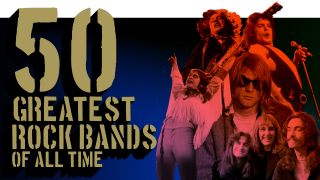In the history of great pub debates, it's one of the arguments most likely to spill over into violence and end friendships forever: just who is the Greatest Rock Band Ever?
Ask most people, and they'll tell you it's The Beatles. Received wisdom and all that jazz. And it's undeniable: there's a fair bit of merit to that answer.
But when we got to compiling the definitive guide of the best rock bands of all time, we wanted to go deep. We didn't want to leave a single rock (yeah, pun very much intended) unturned.
So, we turned to you guys. You're not most people. You're proper music-loving rock fans, representing pretty much everything under rock's vast umbrella, and you think differently. And that's why we asked you to settle the debate, for once and for all.
We asked you to vote for the Greatest Rock Band Ever. We set up a poll, and you came to vote, in massive numbers. Tens of thousands of heartfelt, possibly controversial opinions. And when it was all done we took the data, wrangled it into an enormous spreadsheet, and performed some complicated calculations.
The results, as they say, are in. There's some pretty surprising entries, and some no-not-surprising entries.
But here they are. The 50 Greatest Rock Bands Ever. Official. As voted by you.

50. Roxy Music

Roxy Music guitarist Phil Manzanera might have been right when he told Prog magazine in 2017 that the band "could have been bigger had we had an amazing manager – we’re our own worst enemies.” Certainly they could have been more successful in America, had they been prepared to put in the necessary “graft” (Manzanera’s word) and do the requisite hefty long tours.
"That’s Roxy for you," concluded Manzanera. "The career strategy is non-existent."
Still, they didn’t do badly. The group where a young Bryan Ferry and Brian Eno cut their teeth, they dominated Britain’s glam-era pop scene in the first half of the 70s, despite having next to nothing in common with Slade, Sweet et al and not being a pop group – or even a rock group. A band of "inspired amateurs" (again, Manzanera's words), they were essentially a band of punks five years ahead of schedule.
Roxy’s stylised glamour was catnip to the new romantics, their sense of provocation a beacon to the punks. Fearless and with a taste for overt experimentation, Roxy were radical and exciting, pushing boundaries without any concern for commercial compromise. Combined with their powerful songwriting and the band’s devotion to individuality, it was a potent combination that ripped up the rule book of what it meant to be 'rock', and we were all the better for it.
Their contribution to rock was cemented when they were inducted to the Rock and Roll Hall of Fame in 2019.
49. King Crimson

Forget a linear career; there’s nothing stable or logical about the way King Crimson have conducted themselves since forming in 1968. This most exhaustive and exhausting of prog rock bands have had nearly two dozen full-time members across five decades.
Their mid-70s drummer Bill Bruford once called Crimson “a terrifying place”, and that’s perhaps the best description of the band started by guitarist Robert Fripp and drummer Michael Giles, when their previous band Giles, Giles And Fripp ceased to be of interest to them.
The pair abandoned that trio’s whimsical pop in the pursuit of more headstrong – or head-fuck – music, and brought in multi-instrumentalist Ian McDonald, bassist/vocalist Greg Lake and lyricist Pete Sinfield. Since then Fripp has remained the sole constant.
It’s easy to suggest that it’s Fripp’s vision, his drive, that has kept Crimson at the forefront of pioneering yet idiosyncratic music. But he’s done more than that. Understanding that creativity is often born out of turmoil and disagreement, he has often brought in highly talented, strong-minded people.
This has led to a body of work that is not only the envy of many of their peers, but has also become hugely influential. Bands such as Tool and Porcupine Tree have cited Crimson as major inspiration, but they have reached far beyond the progressive world – Kanye West sampled 21st Century Schizoid Man for his 2010 hit Power, and British techno band Opus III covered I Talk To The Wind in 1992.
It’s no wonder the tentacles of Crimson have touched so many disparate artists. They have never stood still and developed in a single direction, instead reaching out through all corridors and textures within music. This has taken them on a journey not only through the usual pastures of jazz, classical, blues and folk, but also across the globe in terms of their reach.
Yet against the odds they have also had some considerable commercial success – eight of their albums have made the UK Top 40.
But the band’s success truly lies in the fact that they are best described simply as King Crimson.
48. ZZ Top
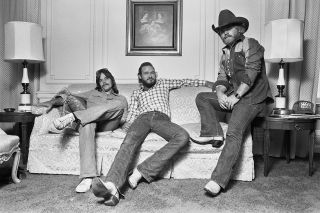
Two guys with beards, and a guy called Beard who doesn’t have a beard. Those 1980s videos. The car. The keyring. The furry, twirling guitars from Back To The Future III... To many people those things are the essence of the self-styled Li’l Ole Band From Texas.
But such memorable images are far from being the band’s only contribution to rock. ZZ Top – Billy Gibbons, Dusty Hill and Frank Beard – are certainly among America’s musical elite; a band who took blues rock, gave it a Texan tweak, and have for 50 years made gutsy music that amuses, amazes and gets your body moving.
From their Houston beginnings in 1969 when guitarist Gibbons, then with The Moving Sidewalks, teamed up with bassist Hill and drummer Beard from The American Blues, ZZ have defied convention. They made such an impact with their first three albums – ZZ Top’s First Album, Rio Grande Mud and Tres Hombres – that they were soon one of the biggest live attractions in the US. In the mid-70s they proudly had a map of Texas as their stage flooring, and had cacti and corralled livestock on stage with them.
After 1976’s Tejas, the trio decided on a three-year break, returning in 1979 with the Deguello album, by which time both Gibbons and Hill had grown those trademark beards.
Outside of the US, ZZ Top remained a cult phenomenon... until 1983’s Eliminator appeared from out of nowhere and rearranged the charts. The logic was simple: easy-on-the-ear songs, a modern production, and MTV-friendly videos that had a potent mix of sex, laughs and hardware. Suddenly ZZ Top were everywhere. Like Aerosmith and Alice Cooper would do later in the decade, ZZ had reinvented themselves. And with staggering success.
Of course, it was never going to last. Within a few years their commercial star was on the wane – at least as far as record sales were concerned. It didn’t bother them. They even survived a scare when Hill inadvertently shot himself in the chest while taking off a boot (don’t ask).
ZZ Top have become a treasured American institution; icons who love to upset the establishment. And as of 2012's La Futura, they're still making great music.
47. Ramones

Frayed and ragged like well-worn sneakers, the bubblegum blitz of New York’s Ramones was as simple and blunt as a mallet. As with Motörhead and AC/DC, casual listeners will argue that if you’ve heard one Ramones album you’ve heard them all. Then again, if it ain’t broke, don’t turn into Metallica.
Born in 1974 at New York’s legendary CBGB dive, the musically unschooled and outwardly unwashed Ramones unwittingly scribbled the book of 1-2-3-4, do-it-yourself punk rock. Along the way they became slouched heroes to future generations of speed freaks, grunge geeks and pawn-shop guitar slashers with neither the dexterity nor the inclination to mimic Led Zeppelin or Eric Clapton.
Nicking their fictional surname from either Paul McCartney’s one-time pseudonym (Paul Ramone) or producer Phil Ramone (depending on who you ask), the founding fab four ‘brothers’ were singer Joey (aka Jeffrey Hyman), guitarist Johnny (John Cummings), bassist Dee Dee (Douglas Colvin) and drummer Tommy (Tommy Erdelyi). The Ramones managed only one gold album (1988’s double-vinyl ‘hits’ compilation Mania), but spent nearly 30 years inciting pogo pits and forging the loud-and-fast blueprint that would inspire everyone from the Sex Pistols to Guns N’ Roses.
While Ramones concert tours stirred mania overseas, they barely registered a blip on their US homeland’s radar.
Praise was hardly faint, however, as no less a bruiser than Lemmy himself wrote a namesake tribute to the Ramones for Motörhead’s 1916 album. On the more profitable and polite side of rock’s velvet rope, U2’s Bono and Pearl Jam’s Eddie Vedder both continue to be outspoken in their utmost respect for the black-leather boppers.
“I was at college when an advance copy of Ramones came into one of the local record stores," Nirvana producer Butch Vig told us in 2016. "I remember being in there when the guy put it on, and just being floored by how amazing it sounded. So I went back a week later and was first in line when it went on sale.
"It really was a startling sound for that time. There were all these bands like Emerson Lake and Palmer that would do these extended muso solos. The Ramones were the exact opposite of that, they were so stripped-down and bare-boned and so fast. It was a breath of fresh air, an adrenaline shot.
"In some ways I look at it as an analogy to when I produced Nirvana’s Nevermind. It’s the same kind of thing, where the music sounded fresh and vital and really shook up the music scene. The difference being that Nirvana sold out about 25 million records and the Ramones never sold jack-shit. For all their credibility, they never got played on the radio and thus never sold many records."
In 2002 the underdogs were finally thrown a bone when the Ramones were inducted into the Rock And Roll Hall of Fame. Sadly, 49-year-old Joey was denied his due, having died a year earlier in the grip of lymphoma.
46. Journey
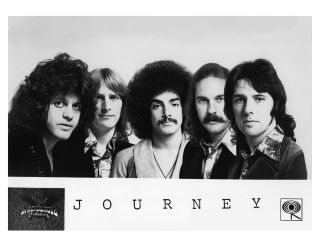
For many, Journey are the band who define AOR better than anyone else. Their catalogue glitters with anthems, which not only have massive choruses, but also the sort of musicianship you might expect from a band who began life as jazz rock instrumentalists, before embracing the melodic rock style for which they’re renowned.
When David Chase, the producer of hit TV series The Sopranos, chose Journey’s Don’t Stop Believin’ as the soundtrack to the climactic scene in the final episode, former Journey singer Steve Perry felt deeply conflicted. A huge fan of The Sopranos, Perry admitted: “I was not excited about the possibility of the Soprano family being whacked to Don’t Stop Believin’.” But in the end Chase got what he wanted, and Perry and Journey got what they had been denied for so many years: genuine iconic status.
For all their success – more than 45 million albums sold in the US alone – Journey have always been a band that music critics have loved to hate, and pilloried as the epitome of corporate rock. Perry himself was mockingly nicknamed The Duck due to his high-register voice. But among fans of classic American melodic hard rock, Journey are revered as masters of the art.
Perry joining in 1977 elevated Journey to greatness and, indeed, saved the band’s career.
Since forming in San Francisco four years earlier, the band had recorded three albums for the Columbia label, all of which were heavily influenced by the Latino-jazz rock of Santana, the group in which both keyboard player Gregg Rolie and guitarist Neal Schon had previously played. But after all three of Journey’s records stiffed, Columbia delivered an ultimatum. As original drummer Aynsley Dunbar recalled: “We were told: ‘Get a singer, get some hit songs or you’re off the label.’”
After a brief trial with Robert Fleischman (who would later go on to front Vinnie Vincent Invasion), Journey recorded their first album with Perry, 1978’s Infinity. It promptly went platinum.
In the 80s, Journey became one of the biggest bands in America, with the Holy Trinity of AOR (Adult Oriented Rock) albums: Escape, Frontiers and Raised On Radio. But in 1987 Perry quit. Journey ended up on ice until his return in 1995.
When Perry left again two years later, Journey found a new singer in Steve Augeri. But in 2006 Augeri suffered problems with his voice and was replaced by Jeff Scott Soto for a world tour.
Incredibly, the band discovered their latest singer via YouTube. Filipino Arnel Pineda’s performance of Journey songs in covers band The Zoo was enough to secure him his dream job. Pineda sounds uncannily like Perry on the Journey’s single Never Walk Away. But as the band and their fans know only too well, there is only one voice of Journey. And that, of course, is The Duck.
45. Cream
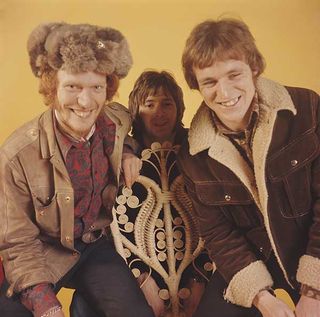
The world’s first supergroup, Cream existed for barely two years in the late 60s, and in their lifetime recorded just two full studio albums. But with their pioneering fusion of rock, blues and jazz, they directly influenced an entire generation of musicians – and therefore the course of rock music over the next decade.
Before late drummer Ginger Baker, bassist Jack Bruce and guitarist Eric Clapton formed Cream in 1966, most British pop music stuck pretty rigidly to a verse/chorus format, and any instrumental solo was generally confined to repeating the melody.
Cream changed all that. For example, they took the two-note riff that comprised Willie Dixon’s Spoonful and stretched it from two-and-a-half minutes to six-and-a-half, exaggerated it, and improvised all around it with a dazzling display of virtuoso playing. This wasn’t a new idea, but it was largely confined to jazz – a style that by the mid-60s, as Frank Zappa famously remarked, “wasn’t dead, it just smelled funny”.
The dynamic that propelled Cream hinged on Baker and Bruce’s jazz backgrounds and Clapton’s blues roots. Clapton may not have had the musical knowledge and technique that Baker and Bruce possessed, but he had a God-given gift that enabled the group to justify their audacious name.
Although Cream had already enjoyed UK chart success with their debut Fresh Cream, released in December 1966, the band had actually been together less than a year when they started recording seminal album Disraeli Gears, and had only just signed an American deal with Atlantic Records. Any idea that Cream were some kind of blues revivalists was dispelled by the forceful originality of the songwriting on Disraeli Gears and the many highly distinctive performances on a collection that has most surely stood the test of time.
On stage the chemistry within Cream was staggering. “It was as if something else had taken over,” said Baker in 2014. “You’re not conscious of playing. You’re listening to this fantastic sound that you’re a part of. And your part is just… happening. It was a gift, and we three had it in abundance.”
Clapton was more succinct. He called it “blues, ancient and modern”.
44. Motley Crue
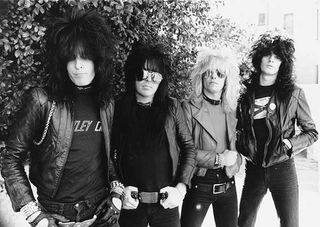
Perhaps it was their manager, Doc McGhee, who best summed up Mötley Crüe. Recalling the years when he handled the business affairs of these self-styled Bad Boys of Hollywood, McGhee stated in the Crüe’s autobiography, The Dirt: “I spent 10 years of my life apologising for that band. As their manager, that’s all I really did. Apologise.”
McGhee is no saint himself: in 1988 he received a suspended five-year prison sentence for drug-trafficking offences. But when this hard-nosed businessman who made a fortune managing Mötley Crüe declared: “There was nothing I liked about them,” it confirmed beyond all doubt their reputation as the most depraved rock’n’roll band of them all. Nobody, not even Ozzy, Zeppelin, Keith Moon or Guns N’ Roses, has wreaked havoc with such reckless abandon as Mötley Crüe.
Formed in Los Angeles in 1981, the Crüe – bassist Nikki Sixx, drummer Tommy Lee, guitarist Mick Mars and singer Vince Neil – were kings of the Hollywood hair metal scene and relished all the perks that came with that title. With an inexhaustible supply of booze and drugs, the Crüe partied so hard throughout the 80s it’s a miracle they all survived.
Sixx almost croaked twice, overdosing on heroin in London, where a dealer dumped his apparently lifeless body in a skip, and in LA, where he was resuscitated with adrenalin shots – inspiring the Crüe anthem Kickstart My Heart. In the end the sole casualty of the Crüe’s wild years was Hanoi Rocks drummer Nicholas ‘Razzle’ Dingley, who died in the passenger seat of Vince Neil’s sports car after the singer crashed it during a booze and drugs bender in 1984.
Incredibly, amid all the mayhem, Mötley Crüe became one of the biggest bands in the world, selling more than 50 million albums. Having cheated death and survived some lean years when Vince and then Tommy left the band, the Crüe are still in business – sort of. Following the movie adaptation of The Dirt in 2019, interest in the band has renewed itself once again. Despite signing a touring cessation contract in 2015, which was meant to signal the end of the band, rumours are rife of a reunion being on the cards, and a huge tour planned for 2020.
What happens next is anyone's guess.
43. Rainbow

It was with Deep Purple that Ritchie Blackmore became legendary, but his legacy extends far beyond Purple. With Rainbow – the band he formed after quitting Purple in 1975 – he made nine studio albums, including such classics as Rising and Down To Earth.
Blackmore always played smart, and never more so than with his brilliant reinvention of Rainbow in the late 70s. Their second album, Rising, captured the band at their peak. Driven by the guitarist’s single-minded vision, it pioneered an epic sound whose influence can still be heard today. Rising had a power and grandiose quality perfectly illustrated by its cover art and Blackmore had retained only Ronnie James Dio in a new line-up featuring heavy-hitting drummer Cozy Powell.
But by fourth album Down To Earth three years later, Blackmore had decided that Dio’s demons-and-wizards shtick was passé, replacing him with Graham Bonnet, whose quiff and Hawaiian shirts didn’t sit well with Rainbow’s denim-and-leather demographic. However, he was ideally suited to the radio-friendly rock of Down To Earth.
With former Purple bassist Roger Glover joining the band and producing the album, Rainbow had Top 10 hits with Since You Been Gone and All Night Long, while Eyes Of The World maintained a link to the past.
The Lord Sugar of his day, Blackmore fired a lot of people from Rainbow. An exception was Bonnet, who quit when making the follow-up to Down To Earth. But Blackmore had the last laugh. With new singer Joe Lynn Turner, Rainbow had their biggest hit album and single with Difficult To Cure and I Surrender, both reaching No.3 in the UK.
Even by the standards of the 70s, the story of Rainbow is a tangle of creative genius, colourful characters and personal tensions. In the space of their time together, Blackmore assembled one of the greatest rock bands ever – and then dismantled it. More than once.
42. Pearl Jam

Pearl Jam are grunge’s great survivors. Unlike Nirvana, Soundgarden, Alice In Chains and the other major bands from the Seattle scene’s graduating class of 1991, they’ve never gone away, either permanently or temporarily. And while they’ve endured their share of traumas – not least the deaths of so many friends and contemporaries – they’ve ridden them out.
But then resilience is part of Pearl Jam’s DNA. They were born in tough circumstances: guitarist Stone Gossard and bassist Jeff Ament were previously members of Mother Love Bone, whose career had barely got out of the traps when singer Andrew Wood fatally OD’d.
They turned their grief into hope, channelling it into multimillion-selling debut album Ten, only to be disparaged by the gatekeepers of cool as grunge fifth columnists. Much of the scorn was directed at singer Eddie Vedder, the San Diego surf rat seen as an interloper in the insular north-west scene. His rich baritone and heart-on-sleeve sincerity sat at the opposite end of the spectrum to Kurt Cobain’s weaponised irony and punk-rock sneer.
The derision didn’t dent Pearl Jam’s rise – their second album, 1993’s Vs., sold nearly a million copies in its first week. But Vedder in particular hated their success. The band pushed back hard against it, refusing to make videos or be interviewed.
By late 90s the insanity was starting to fade and things had reverted to something approaching normality. Their record sales were a fraction of what they once were – 1998’s Yield sold a million copies compared, to Ten’s eventual 13 million – and you suspect no one was happier about that than Pearl Jam.
There were still hard times to endure, not least the tragedy of nine fans who were crushed to death during the band’s set at Denmark’s Roskilde festival in 2000. But for the most part their troubles were largely behind them.
Since the turn of the millennium, Pearl Jam have existed outside the mainstream music industry. These days much of the band’s potency comes from their devotional live shows rather than from the commercial impact of their albums, repositioning them as a kind of Gen-X Grateful Dead (they were one of the first bands to make recordings of their gigs available to fans as ‘official bootlegs’). But it underlines that Pearl Jam in 2019 are much the same as Pearl Jam in 1991: a band of the people, for the people.
41. Marillion

If progressive rock bands are supposed to be boring, nobody told Marillion. The making of their classic album Misplaced Childhood – in early 1985, at Berlin’s Hansa Studios – was effectively one almighty bender. Singer Fish led the debauchery, blowing his wages on sex workers, sampling heroin for the first (and last) time, stripping naked in a bar to win a bet, crashing a car in a race round the city, and throwing bricks over the Berlin Wall in an attempt to set off landmines.
Marillion might have been inspired by the music of Genesis and Yes, but they could party like Guns N’ Roses.
Formed in Aylesbury, Buckinghamshire in 1979, the band were originally named Silmarillion after a posthumously published work by JRR Tolkein. The name was shortened in 1981, the same year that charismatic Scotsman Fish (born Derek William Dick) joined the group. After signing to EMI the following year Marillion released four studio albums – all of them UK Top 10 hits – before Fish left for a solo career in 1988.
His replacement Steve Hogarth, formerly of The Europeans, this year celebrates 30 years as Marillion’s frontman. Yet Hogarth will always be considered ‘the new guy’, such was the impact of the music that Marillion made with Fish, especially Misplaced Childhood and its hit single Kayleigh, a song which had the singer credited for inventing an original name. As he once commented: “I’ve got used to signing autographs for 13-year-old Kayleighs.”
In the Fish era, Marillion were standard bearers for progressive rock, but with Hogarth the band have been progressive in the broadest sense. Their music has evolved far beyond those primary influences, and after being dropped by EMI in 1996 Marillion created a new, internet-based business model that saw them thrive as an independent cottage industry. Eight years before Radiohead sold In Rainbows exclusively online, Marillion financed their album marillion.com by inviting 30,000 fans on their database to pre-purchase the album before it was even recorded, inventing crowdfunding in the process.
It’s ironic that a band once derided for sounding like the dinosaurs of 70s rock should prove to be pioneers of the internet age. But this forward thinking secured Marillion’s future. In 2016 they released FEAR (Fuck Everyone And Run), an album which suggested that they'd taken all the most emotionally potent and fervently dynamic moments from Marillion's decades together and moulded them into some new, exponentially emboldened form. Indeed, far from being dinosaurs, Marillion are taking prog directly into its future.
